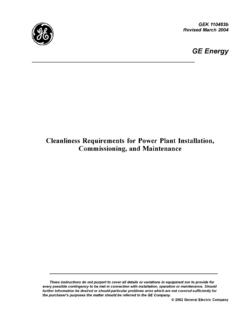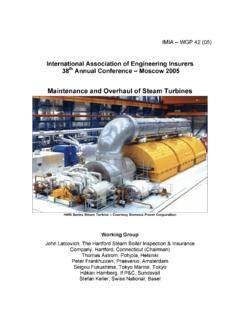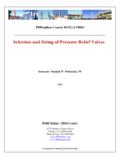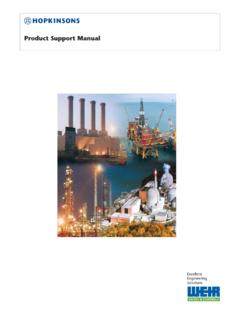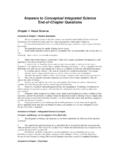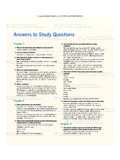Transcription of QUESTIONS AND ANSWERS Phosphate Hideout
1 During Phosphate Hideout , littleor no change in Phosphate and/orpH values occurs when chemicalcharges are added to the systemsince fresh Phosphate may precipi-tate along with that which hasalready occurred. The readings forpH and Phosphate are typicallyout of control during hideoutwhen the load is increased, andthen again when it is it seems that the phosphatehas mysteriously disappeared, andthat additional charges are unsuc-cessful in increasing the phosphatereading, the actual phosphateinventory in the boiler has notdecreased. It has combined withoxide deposits to form a slightlylower Na/PO4 ratio solid (approxi-mately :1), causing an increasein alkalinity in the liquid phase(bulk water) hence the boilerwater pH increases. When the loadis decreased again, these combina-tions return to the soluble formand the Phosphate returns to thebulk water, causing higher phos-phate readings and lowered HideoutPhosphate HideoutPhosphate HideoutPhosphate HideoutPhosphate HideoutQUESTIONSAND ANSWERSWhat is Phosphate Hideout ?
2 Phosphate Hideout is a phenom-enon that causes boiler watercontrol difficulties. It is defined asthe disappearance, by precipita-tion or absorption, of the ionicphosphate (PO4) species, in theboiler water under high heattransfer or high load the high heat flux or highload condition is reduced, thespecies ( Phosphate ) returns fromhideout, creating even morecontrol difficulties. The magnitudeof Phosphate Hideout and thevariation in load required to causethe phenomenon vary from oneboiler to Hideout is primarily aresult of a temperature-dependentinteraction of sodium phosphatecompounds with iron oxide,which creates a low solubilityreaction product that precipitatesin high heat flux areas or underhigh load conditions. At lowerloads and lower heat fluxes, theprecipitates return to do I recognize it? Phosphate Hideout becomesevident in load swings or start-upswith changing heat input. As theload is increased, the pH increaseswith the decreasing the load is reduced, the pHdecreases and the phosphateincreases, without chemicaladditions to the 1 Normal congruentphosphate-pH boiler 2 Phosphate Hideout causedby lower combustion best way to recognize phos-phate Hideout is to graph loadchanges, pH, and Phosphate overa period of time.
3 The variations ofthe graphs will clearly indicatethat the Phosphate increases withdecreasing load, and that the pHdecreases with decreasing load(see Figures 1 and 2).LoadpHPhosphateIncreasing IncreasesDecreasesDecreasing Decreases IncreasesWhat causes Phosphate Hideout ?Events which may lead to phos-phate Hideout include: Start-up after a chemical cleaning Changes in unit load Changes in burner configuration Metal oxide ingress anddeposition on heat transfersurfacesSMDoes the Hideout vary?Each boiler, due to design andcleanliness factors, will exhibitsomewhat different magnitudesof Hideout . The cleaner the boiler,the less likely Hideout will be foroperating units. For units thathave just been cleaned, the hide-out phenomenon may temporarilyappear severe as Phosphate isconsumed to re-establish theequilibrium between the boilerwater and the iron oxide or heattransfer surfaces, since Phosphate -based passivation solutions arenot typically used for post-clean-ing do I treat it?
4 To treat Phosphate Hideout effec-tively, you must first recognize situation will be greatlyincreased if there is not consistentrecordkeeping and graphing beingdone. Once the Phosphate hideoutis recognized, treatment steps maybe impulsive reaction to hideoutis to add more Phosphate to try tocorrect the low readings. This isinadvisable, however, sinceadding more chemical will onlyworsen the situation when theload is reduced (see Figure 3).Recently, a utility boilerexperienced severe furnace tubecorrosion on the hot side of thetubes. The corrosion was trans-granular in nature and quiteextensive. Along the corrodedareas, large quantities of sodiumiron Phosphate were found,indicating that sodium phos-phate from the boiler water hadparticipated in the 3 Changes in concentrationsof Phosphate with load in unit that isexperiencing chemical forms of Phosphate shouldnot be used in an attempt toincrease the Phosphate most acidic form of phosphateis monosodium start-ups, use mainly tri-sodium not go to heavy will further reduce thesodium: Phosphate ratio.
5 It willalso make the condition whichcauses the Hideout to worsen byallowing acidic conditions the Phosphate at the lowestend of the allowable range. Thiswill vary from boiler to boiler andmay have to be determined over aperiod of this equilibrium level ofphosphate might be quite low, <1ppm for a high pressure boiler, bealert for conditions that mayindicate a condenser tube sodium, silica, and cationconductivity are all indicators of acondenser tube are the consequences ofphosphate Hideout ? Phosphate Hideout causes confu-sion, frustration over uncontrol-lable water chemistry, and corro-sion. Some Phosphate -relatedcorrosion may be frustration resulting fromuncontrollable water chemistrymay be quite high. As lab techni-cians try to maintain the Na/PO4ratio while Hideout occurs, theresultant situation is often non-productive. Significant amounts oftime and money may be spent totry to regain control. Those whosephosphate Hideout problems aresevere will undoubtedly be out ofcontrol more than they are incontrol as the unit cycles.
6 Addingmore Phosphate to the boiler onlymakes the problem worse. Thefrustration of being out of control,wondering if corrosion is occur-ring, and choosing the best solu-tion can be very irritating and leadto expensive consequences of corrosion,frustration, and confusion lead toone final conclusion: phosphatehideout costs do I prevent Hideout ?Based on work done by J. Stodolaof Ontario Hydro, equilibriumphosphate treatment is recom-mended for units experiencingphosphate Hideout to alleviatecorrosion risks and to reduceboiler cleaning Figures 4, 5, 6 and 7 depict,reducing the Phosphate level inthe boiler water greatly reducesvariability with load changes, andmay eliminate the Hideout phe-nomenon in many 6 ppm PO4 @ approximately full 4 ppm PO4 @ approximately full 5 ppm PO4 @ approximately full 7 ppm PO4 @ approximately full chemical COMPANY ONE NALCO CENTER NAPERVILLE, ILLINOIS 60563-1198 SUBSIDIARIES AND AFFILIATES IN PRINCIPAL LOCATIONS AROUND THE WORLDR egistered Trademarks of Nalco chemical Company 1994,1996 Nalco chemical CompanyAll Rights Reserved Printed in 8-96 Bulletin 268 Since Phosphate Hideout is aphenomenon associated withprecipitation of Phosphate /metalsolids in areas of deposits on heattransfer surfaces.
7 It follows thatadequate oxygen control andpassivation of metal surfaces isimportant in the prevention ofphosphate Hideout . Oxygencontrol efforts must be maintainedfor many reasons, but in the caseof Hideout , it is important tocontrol oxygen in the condensatesystem so that corrosion productsare not deposited in the deposits can then interactwith Phosphate during high heatflux conditions to form sodiumiron units where Phosphate hideoutled to corrosion damage, Stodolanotes that removing the minimumphosphate concentration limit andallowing 1 to 2 ppm free causticalkalinity prevented furthercorrosion. Table 1 shows equilib-rium treatment control limits(at 2600 psig [179 barg]).Table 1 Equilibrium phosphatetreatment chemistry control limits*at 2600 psig [179 barg]Control ParameterLimit PO4 (ppb)0 2400 Cation Conductivity ( S/cm) Cl (ppb) 300 SO4 (ppb) 300 Silica (ppb) 160*Pressure dependentPhosphate Hideout in high pres-sure boilers can be recognized,and prevented by changing to anequilibrium Phosphate treatmentprogram.
8 The savings will be seenin reduced operator frustrationand a cleaner, less corroded 1 and 2, Table 1 1991. Electric PowerResearch Institute. EPRI TR-100195. Proceedings:International Conference on Fossil Plant CycleChemistry. Reprinted with permission by EPRI andJ. Stodola, Ontario Hydro, Toronto, Ontario, 3 Originally presented at the 47th AnnualInternational Water Conference, October 27 29,1986, Pittsburgh, PA. Reprinted with permissionby Engineers' Society of Western Pennsylvaniaand J. 4 7 Reprinted with permission byAmerican Power Conference, from 1991 Proceedings.

